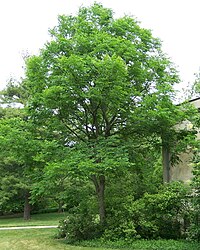Gymnocladus dioica
| Gymnocladus dioica subsp. var. | Chicot, Kentucky Coffee Tree | |||||||||||||||||||||||||||||||||||||||||||||||||||||||
|---|---|---|---|---|---|---|---|---|---|---|---|---|---|---|---|---|---|---|---|---|---|---|---|---|---|---|---|---|---|---|---|---|---|---|---|---|---|---|---|---|---|---|---|---|---|---|---|---|---|---|---|---|---|---|---|---|

|
|
| ||||||||||||||||||||||||||||||||||||||||||||||||||||||
| ||||||||||||||||||||||||||||||||||||||||||||||||||||||||
The Kentucky Coffeetree, Gymnocladus dioicus, is a tree in the subfamily Caesalpinioideae of the pea family Fabaceae, native to the midwest of North America.
Varies from 18 to 21 meters (60–70 feet) high with a spread of 12–15 meters (40–50 feet) and a trunk up to one meter (3 feet) in diameter. A 10-year-old sapling will stand about 4 meters (13 feet) tall. It usually separates 3 to 4½ meters (10–15 feet) from the ground into three or four divisions which spread slightly and form a narrow pyramidal head; or when crowded by other trees, sending up one tall central branchless shaft to the height of 15–21 m (50–70 ft). Branches stout, pithy, and blunt; roots fibrous.[1]
The Kentucky Coffeetree is a relatively fast-growing tree and generally grows in parks and along city streets for ornamental purposes. The tree is typically long-lived however often appears dead for the first six months of its growth. This is because the Kentucky Coffeetree sheds its leaves early during the late spring and therefore appears bare for up to 6 months. The naked appearance of the tree is reflected through the Kentucky Coffeetrees genus name. (Barnes, Wagner at el. 1977) from Michigan Trees.
Like the Sumac, branches are totally destitute of fine spray; smaller branches are thick, blunt, clumsy and lumpish. While other trees lose their leaves, along their twigs and branchlets are borne the buds, the hope and the promise of the coming year. But the Gymnocladus seems so destitute of these that the French in Canada named it Chicot, the dead tree. Even when spring comes, it gives no apparent recognition of light and warmth until nearly every other tree is in full leaf. The casual observer says it bears no winter buds, but there is a tiny pair, wrapped in down and wool, lying sleeping in the axil of every last year's leaf.[1]
Among the trees of the eastern United States, there are two others with similarly large leaves: the Honey locust (Gleditsia triacanthos) and the Devil's Walking-Stick (Aralia spinosa). The expanding leaves are conspicuous because of the varied colors of the leaflets; the youngest are bright pink, while those which are older vary from green to bronze.[1]
The bark is ash-gray and scaly, flaking similarly to black cherry, but more so. The flowers are dioecious, and the fruit is a hard-shelled bean in heavy, woody, thick-walled pods filled with sweet, thick, gooey pulp. The shape of the pods varies somewhat: pod length ranges from about 12.7 to 25.4 cm; unfertilized female trees may bear miniature seedless pods. The beans contain the toxin cytisine.
- Bark: Dark gray, deeply fissured, surface scaly. Branchlets at first coated with short reddish down.
- Wood: Light brown; heavy, strong, coarse-grained; durable in contact with the ground, takes a fine polish. Sp. gr., 0.6934; weight of cu. ft., 43.21 lb .
- Winter buds: Minute, depressed in downy cavities of the stem, two in the axil of each leaf, the smaller sterile. Bud scales two, ovate, coated with brown tomentum and growing with the shoot, become orange green, hairy and about one inch long, before they fall.
- Leaves: Alternate, bi-pinnately compound, ten to fourteen pinnate, lowest pinnae reduced to leaflets, the other seven to thirteen foliate. One to three feet long, eighteen to twenty-four inches broad, by the greater development of the upper pairs of pinnae. Leaf stalks and stalks of pinnae, are terete, enlarged at base, smooth when mature, pale green, often purple on the upper side. Leaflets ovate, two to two and one-half inches long, wedge-shaped or irregularly rounded at base, with wavy margin, acute apex. They come out of the bud bright pink, but soon become bronze green, smooth and shining above. When full grown are dark yellow green above, pale green beneath. In autumn turn a bright clear yellow. Stipules leaf-life, lanceolate, serrate, deciduous.
- Flowers: June. Dioecious by abortion, terminal, greenish white. Staminate flowers in a short racemen-like corymb three to four inches (102 mm) long, pistillate flowers in a raceme ten to twelve inches (305 mm) long.
- Calyx: Tubular, hairy, ten-ribbed, five-lobed; lobes valvate in bud, acute, nearly equal.
- Corolla: Petals five, oblong, hairy, spreading or reflexed, imbricate in bud.
- Stamens: Ten, five long and five short, free, included; filaments thread-like; antehrs orange colored, introrse; in the pistillate flower small and sterile.
- Pistil: Ovary superior, sessile, hairy, contracted into a short style, with two stigmatic lobes; ovules in two rows.
- Fruit: Legume, six to ten inches (254 mm) long, one and one-half to two inches wide, somewhat curved, with thickened margins, dark reddish brown with slight glaucous bloom, crowned with remnant of the styles. Stalks and inch or two long. Seeds six to nine, surrounded by a thick layer of dark, sweet pulp.[1]
Cultivation
Propagation
Pests and diseases
Varieties
Gallery
References
- ↑ 1.0 1.1 1.2 1.3 Keeler, Harriet L. (1900). Our Native Trees and How to Identify Them. New York: Charles Scriber's Sons, pp. 109–112.
External links
- w:Gymnocladus dioica. Some of the material on this page may be from Wikipedia, under the Creative Commons license.
- Gymnocladus dioica QR Code (Size 50, 100, 200, 500)


